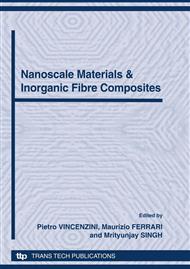p.40
p.45
p.50
p.58
p.68
p.74
p.80
p.86
p.92
Thermal Conductivity of Ceramic Nanocomposites – The Phase Mixture Modeling Approach
Abstract:
In nanocrystalline materials the grain boundaries must be considered as regions of finite thickness with properties different from the crystalline bulk material present in the crystallite cores. Thus, dense (i.e. pore-free) single-phase nanocrystalline materials can be considered as quasi-twophase systems whose effective properties can be calculated when quantitative thickness information is available and the property value of the grain boundary phase can be reliably estimated. Similarly, dense two-phase nanocomposites may be considered as quasi-three-phase systems and their effective properties can be predicted using an analogous phase mixture modeling approach. In this contribution this is done for the thermal conductivity of alumina-zirconia nanocomposites. A twostage homogenization procedure is applied, consisting of a first step in which the alumina-zirconia composite is treated as a symmetric-cell material, and a second step in which the highly disordered grain boundary phase is treated as a matrix-phase, coating the crystallite cores. The individual averaging steps are discussed with respect to the two- and three-point bounds, and the resulting grain size dependence is compared with that of pure alumina and zirconia, and literature data.
Info:
Periodical:
Pages:
68-73
Citation:
Online since:
October 2010
Authors:
Price:
Сopyright:
© 2010 Trans Tech Publications Ltd. All Rights Reserved
Share:
Citation:


